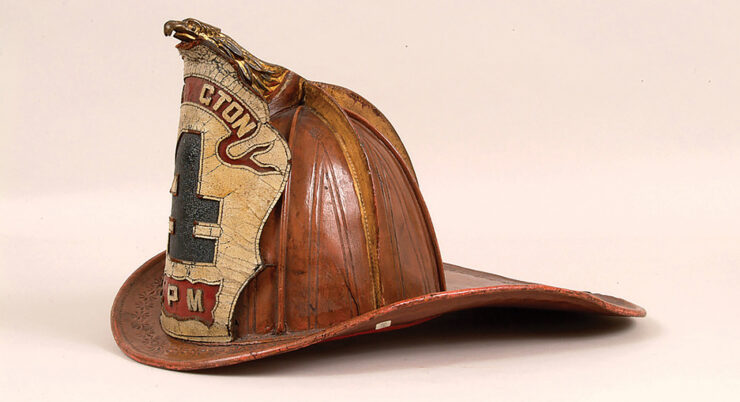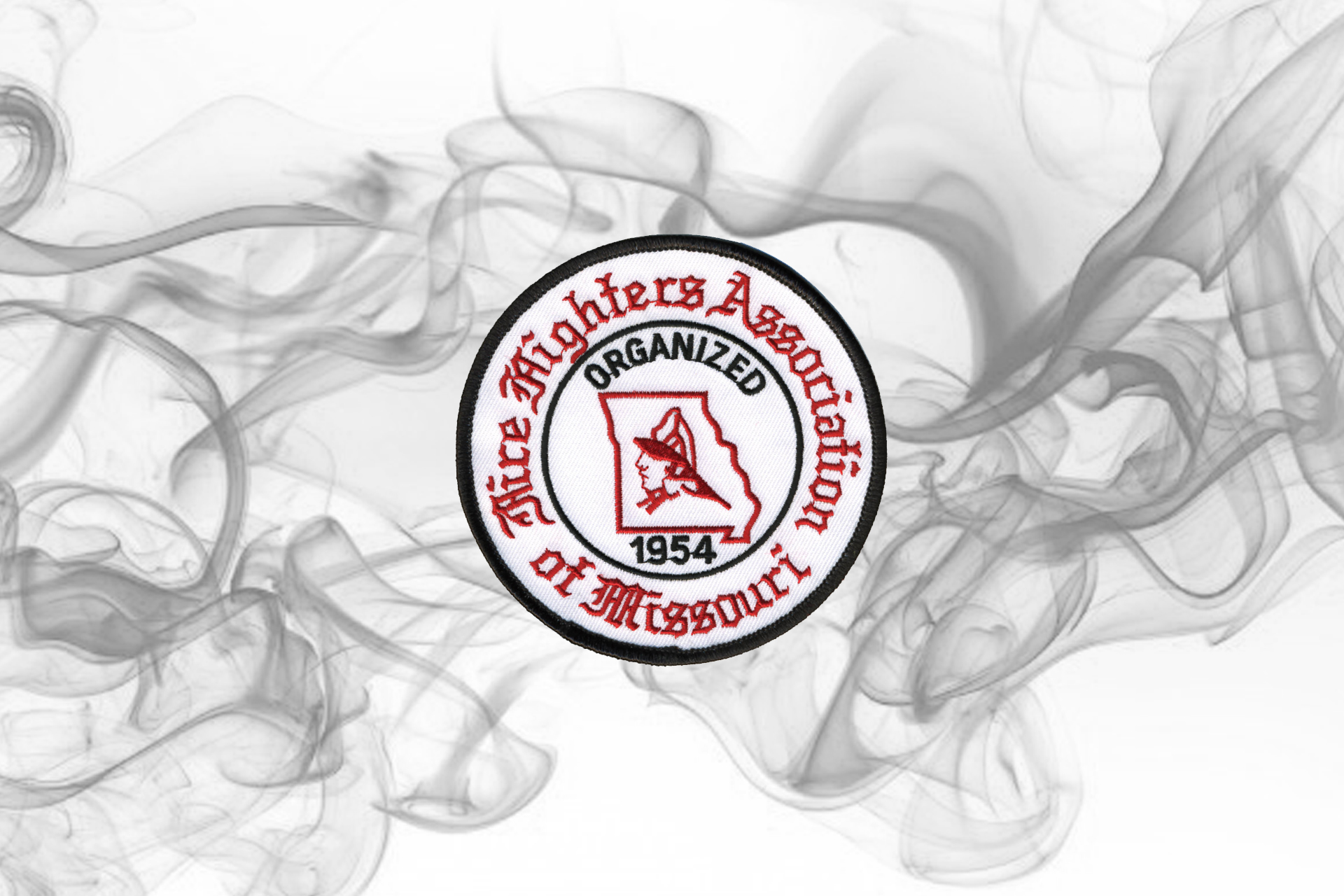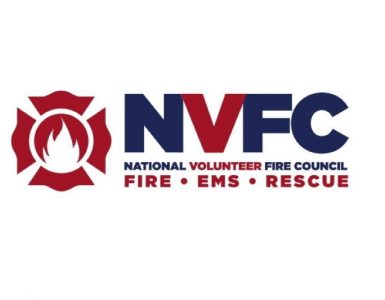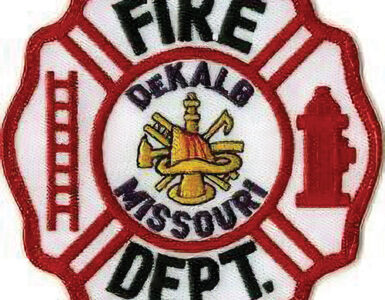A Traditional Part of Fire Service History
Firefighters wear an assortment of personal protective equipment (PPE) as part of their profession, whether career or volunteer. The turnout (bunker) coats, pants, boots, gloves, self-contained breathing apparatus, and other pieces of the fire protective ensemble are all part of the occupation. However, no piece of equipment is more recognizable than the firefighter’s helmet. Though new materials and designs have produced a variety of styles and configurations over the years, the most preferred helmet style for firefighters in the United States is based on the configuration of an 1800s leather fire helmet. So, how did this all come about? The circumstances of the development of the American-style fire helmet is another remarkable story in fire service history.
Though the American fire helmet didn’t begin with its current configuration, the style of helmet we will be examining for the most part in this article is usually referred to as the “New Yorker” style fire helmet. We will find that the City of New York played a major role in the history of the American fire helmet.
In the Beginning
Even young children today quickly come to recognize the traditional style of the fire helmet that identifies a firefighter. Though the iconic style of the American fire helmet has remained fairly constant for over 150 years, the headgear for firefighters didn’t start out that way. In the early days of fire protection in the American colonies along with the bucket brigades, there was no specific protective equipment worn by the brigade members. So the traditional tri-corner hat worn by many of the male colonists served as limited head protection. Based on research it was found that most references credit Jacob Turk (also spelled as Jacobus Turck) as inventing the first specific hat for firefighting use. Jacob was actually a junior, though most references do not identify him as such confusing him with his father who was a city Alderman.1 Jacob was a gunsmith by trade. In 1736 he was appointed as “Overseer of Fire Engines” for two new Newsham hand pumpers purchased by New York. Turk invented the first fire helmet in 1740, and “it was leather, with a high crown and wide brim.”2
According to Arnold Merkitch, a firefighter and author of the 1981 book, Early Fire Helmets, the first reference he found regarding the wearing of specific fire hats occurred in 1762 where Firemen in New York “were directed to wear leathern caps when on duty.”3 In 1764 in Boston, the first “Fire Hat” that was used was “a black leather ‘Jockey Cap’ with a ‘Pewter Badge’ bearing the number of the Fire Company.”4 From these developments, we can see the beginnings of a method to identify authorized firemen on the scene and to which fire society or company they belonged.
The next innovation in fire hats came about in 1788 in Philadelphia, “it was a round hat of stovepipe shape with a narrow brim.”5 This style hat was to be copied and worn, with different variations, by firemen throughout the early American states. Painted hat fronts and “front pieces” were added to these hats over time, and laid the foundation for the concept of a shield or helmet front on later helmets.
In 1824, a man named Matthew Du Bois, who was a saddler and cap maker, was first credited with adding a metal rod around the brim or edge of the fire hat so it could be better shaped and not distort or deform from the heat or water from the fire.6
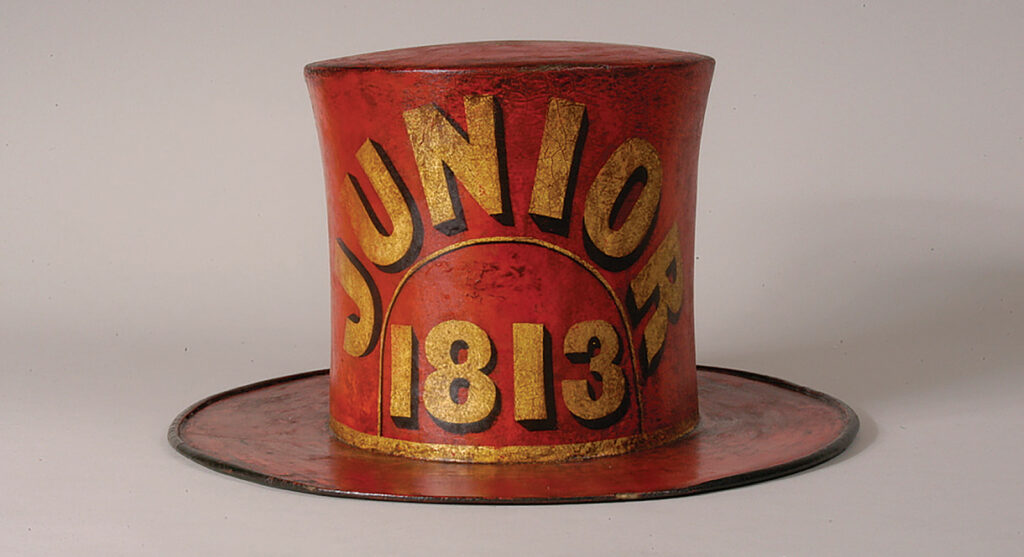
Henry T. Gratacap
Not only did some cities and towns require firemen to wear identification on fire scenes, the fireman themselves liked to wear symbols of their volunteer avocation. Though there were numerous local artisans making regalia for firemen to wear such as hats, helmets, and capes (yes, back in the day men wore capes), not much thought had been put into the actual occupational design of the fledgling fire helmet up to this point. Many of these leather artisans in New York were harness and trunk makers.
Along comes Henry T. Gratacap, who many consider the father of the American fire helmet. Gratacap was an apprentice to William Hinton, who was a leather artisan and would also go on to make fire helmets.7 In 1836, Gratacap established his own business at 329 Broadway in New York.8 His company begin “making luggage for overseas voyages with specially treated leather for durability.”9 Gratacap was also a volunteer fireman with New York Fire Department and “in 1858 was foreman of the Columbian (Fire) Company.”10 He was well respected for his durable leather luggage that stood up to water and heavy use. Taking his artisan expertise and his real-world experience in fighting fires, he set out to design a true fire helmet that would protect the fireman and stand up to the fire environment. The Smithsonian American History Museum describes Gratacap’s creation as:
A specially treated leather helmet with a segmented “comb” design led to unparalleled durability and strength. The elongated rear brim (also known as a duckbill or beavertail) and front piece were 19th-century innovations that remain the most identifiable feature of firefighters’ helmets. The body of the helmet was primarily designed to deflect falling debris, the rear brim prevented water from running down firefighters’ backs, and their sturdy crowns could aid, if necessary, in breaking windows.11
The “comb” was a way to add strength to the helmet. A comb is basically a ridge formed on the outside of the helmet where two pieces come together and are sewn. This is how the rounded cone shape of the helmet crown is made with multiple pieces of shaped leather. Most common were four and eight comb helmets. So a construction feature became a valued design feature. Manufacturers also molded into the leather additional combs or ridges for shape, strength, or artistic design. In Duchesne’s book, Fireman’s Headgear in America 1658-1918, he reports that presentation helmets could have 148 to 180 combs.12
Gratacap’s eight comb helmet with an elongated rear brim became known as the “New Yorker” style fire helmet. It was adopted by the New York Fire Department sometime in the 1800s, though a specific date was not identified. The volunteer New York Fire Department was organized in 1731 and lasted until 1865 when it was disbanded and a career department took over fire protection responsibilities.13
Gratacap was also the first to develop the stitched or raised frontispiece and add a “finial” figure or “front holder” on the top front of the helmet to hold the top of the shield. The first finials were made of leather and later he teamed with the Cairns Company to produce brass finials that were more durable in holding the shield.14
The Gratacap helmets can be identified by a number of accouterments or trim options. The front and side brim could be embossed or stamped with various vine patterns or floral motifs. The rear brim usually bore a complex design with “H.T. Gratacap” in the center and “New York” under it. Another variation included a date, all embossed within a horizontal oval.15 Of course due to Gratacap’s helmet popularity, his design and embossed embellishments were soon copied by a number of helmet makers adding minor variations and their own company’s name.
Gratacap’s company at one point in time was producing an average of 100 fire helmets a week. The cost at the time of a regular helmet was four dollars, and a fancy presentation helmet could run $75.16
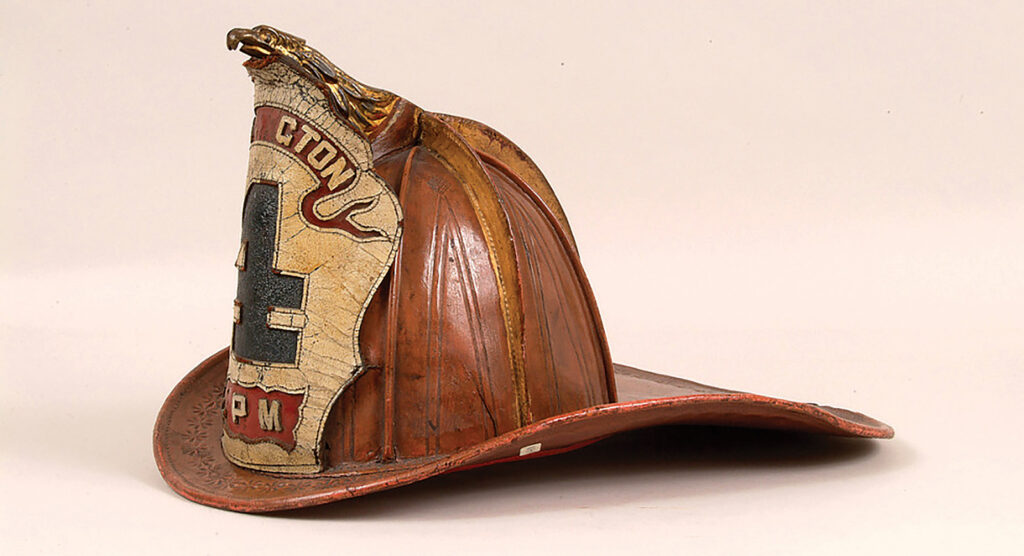
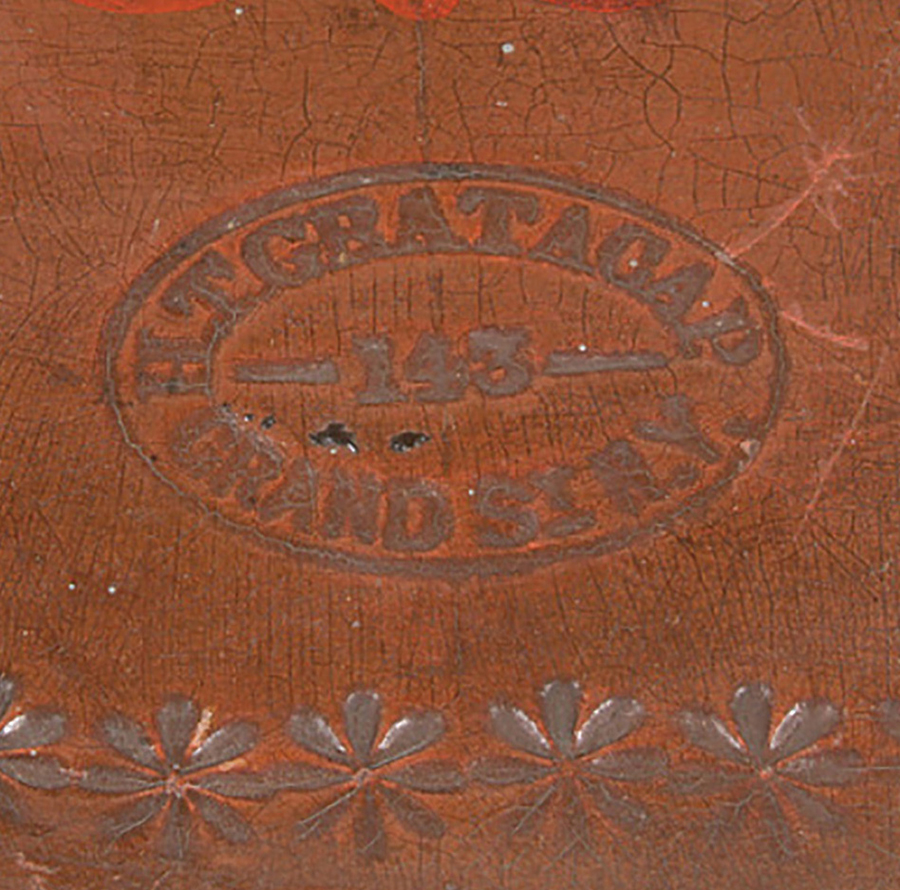
Other Early Helmet Makers
In tracing the history of fire helmets, it is sometimes difficult to determine who the manufacturer was for a particular helmet. Early hats and helmets, like fire buckets, were made by local leather artisans and might have no identification label or a simple paper label that has been lost or disintegrated over time. Some early makers did stamp or emboss their names into the brim of the leather helmets they produced. The practice of paper labels and stamping were “eventually replaced by a brass identification disc.”17 Cairns and Brothers who bought Gratacap’s company followed this practice with a variety of disc types used over the years.
Adding to the confusion, around the 1890s various fire equipment supply businesses were organized who bought helmets from well-known helmet makers and inserted their own label. Merkitch related that he had seen a fire helmet with three different identification labels or stamps. Apparently bought from one, re-sold by another, and then repaired at some point by yet another company adding to the uncertainty of its origin.18
Gratacap’s unique and durable style fire helmet were instrumental in setting the fire helmet standard of the day. However, it didn’t take long for other leather artisans and companies to follow suit and get involved in making and selling leather fire helmets. There were over 20 businesses making or selling fire helmets in New York during the 1800s.19 Philadelphia and Boston were listed as having quite a few helmet makers.
In 1869 after approximately 33 years of running his own business, Gratacap sold it to Cairns. Cairns would become Cairns and Brothers and become one of the major fire equipment supply houses and fire helmet makers in the United States.20 Two brothers, Jasper and Henry, formed Cairns and Brothers. The leather fire helmet business remained a core part of their fire equipment supply business as they grew over the years. Starting out in New York in 1869, they moved several times in the city until finally moving to Clifton, New Jersey in 1948.21
The shape of the “New Yorker” helmet has remained virtually unchanged through approximately 190 years of faithful and steadfast service. “Leatherhead” is a term used for a firefighter who uses the leather helmet for protection from the hazards they face every day on the streets. Of historical note, though firefighters were definitely the first to be called leatherheads, the term was also to become synonymous with athletes in a newly developing American sport. In the early days of the game of football, protective gear was sought for the players. A leather helmet was first worn in the Army-Navy football game of 1893.22 A padded close-fitting leather helmet came into use by football players in the early 1900s and the men who played the game were also known as “leatherheads.”
Helmet Definitions, Construction, and Markings
To help visualize the characteristics of the typical vintage leather fire helmet design and corresponding nomenclature, an illustrated drawing is provided.
How would one define a fire helmet? A general brief definition might be a head covering worn by firefighters for protection while performing potentially hazardous fire and rescue duties. The helmet can be made of leather or various composite materials, has a distinctive high crown, circular brim with a longer back brim, and may have identifying front piece and lettering. Wikipedia, the all-knowing web source provides a little more description and history in their definition, which says, “For centuries, firefighters have worn helmets to protect them from heat, cinders and falling objects. Although the shape of most fire helmets has changed little over the years, their composition has evolved from traditional leather to metals (including brass, nickel and aluminum), to composite helmets constructed of lightweight polymers and other plastics.”23
How does an official source define the fire helmet? The National Fire Protection Association (NFPA), a consensus standard making organization in the fire service, defines a structural fire fighting helmet in their NFPA 1971 Standard as: “The element of the protective ensemble that provides protection to the head.”24 Accurate but not very descriptive of the historic fire helmet.
Construction
Though fire helmets were originally made of high-grade leather (tanned cowhide), because of leather shortages in the 1800s it was not uncommon for some of the manufacturers to use buffalo hide for both fire helmets and leather fire hose.25 This led to varying grades of leather and their durability over time.
Combs on the exterior of the helmet where pieces of the crown came together and were sewn helped create the shape and durability of the helmet crown.
Finials of front piece holders were added to hold the shield or stitched front piece to the helmet. They were developed by Gratacap for use on helmets with tall front pieces. Tall fronts became a matter of personal preference and a prestige thing over time. Officer helmets and presentation helmets were adorned with the taller fronts. More traditional six-inch fronts went to eight and ten inches high. Taller is better right. Or at least more impressive. Especially seen on parade or ceremonial helmets. The tall eagle holder or finial was predominantly used as a holder for these high fronts.
Where did the idea to use an eagle as a finial come from? This is another part of fire service history that comes mostly from stories and oral traditions. Though most firefighters assume the eagle stands as a patriotic symbol and denotes a sense of pride, no one knows for sure. One story related by Duchesne is that in 1825 a sculptor, name unknown, created a commemorative figure for a fireman’s grave in New York that depicts a fireman rescuing a child and on his helmet is an eagle. Thus fireman got the idea from this.26 A similar story is related by Chaplain Doug Farmer in an article related to blessing fire helmets.27 And yet another story is that Gratacap saw this and got the idea to make the first front holder out of leather depicting an eagle. From there he partnered with Cairns to make a brass eagle holder. This soon spread to a variety of designed holders or finials that depicted various animals. However, the eagle was one of the most popular designs and is predominately used as a front holder today.
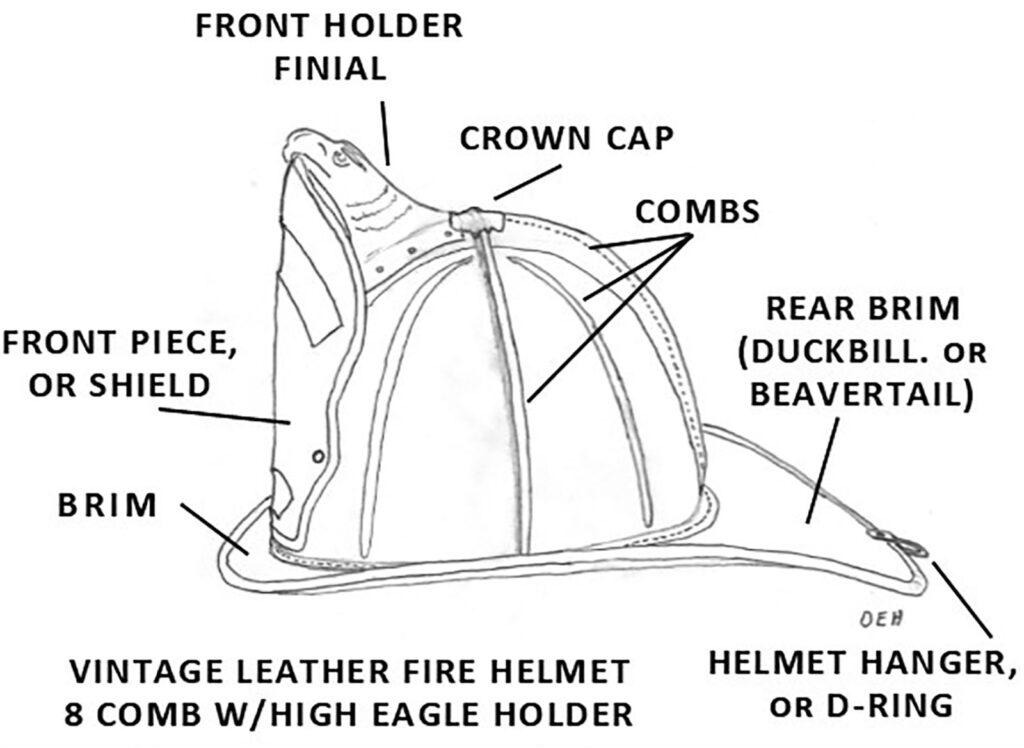
Identification Tags
Besides paper labels and tags and the use of embossed stamps in the helmet leather, usually in the brim, a number of manufacturers began using metal discs attached inside the helmet. These metal discs were primarily made of brass in the beginning and attached to the inside center of the crown. Some of these discs had holes that penetrated through the crown and came out underneath the brass crown cap and were used to ventilate the crown of the helmet.
Cairns and Brothers used metal discs for an extended time period during the manufacturing of their helmets. An example of their brass tag seen in Duchesne’s book bares the date 1896.28 Other information has their aluminum tags undated but with New York on them as helmets made sometime before 1948. At that time they started using a letter date code on their helmets beginning with the capital letter “A” and ending in “Z” for helmets in 1997-98.29
A special note of caution. Helmets with a year prominently displayed on the rear brim of the helmet, usually as painted numbers, indicate the founding date of the fire company, fire society, or organization. They do not indicate the date the helmet was made, so don’t be misled.
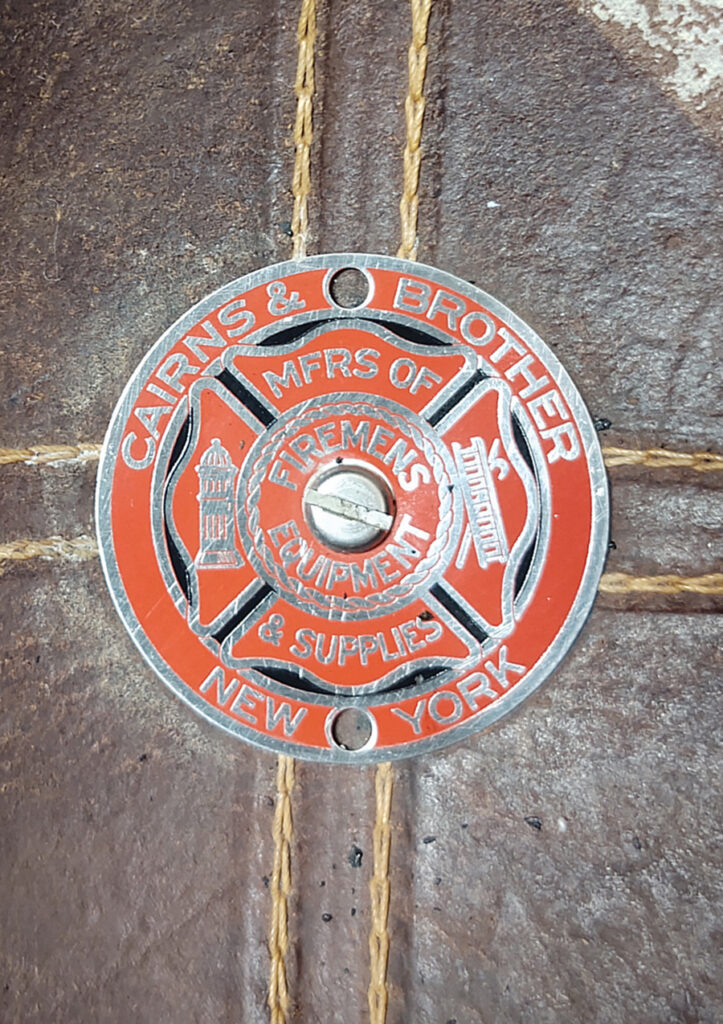
Helmet colors
Early helmets were made of tanned leather and had a natural brown color after finishing with preservative oils. Leather could also be dyed or the helmet painted after construction. Helmet colors in the early days varied depending on the colors favored by the local community, fire company, or individual preference of the owner. Even today this may play a factor in some cases. However, the use of colors to identify rank got started in the early days of fire hats and then helmets. By the 1830s New York was standardizing fire cap colors. Merkitch states, “in general all officers, except engineers wore black caps with a white front, lettered in black, and all Privates wore black caps with black fronts lettered in white.”30 In general today we see most fire departments with chief officers in white helmets, company officers and engineers in red or yellow, and firefighters in black helmets.
A Word About Antique Fire Helmets
Though this article provides information that would aid in determining the manufacturer and historical dating of antique fire helmets, the information presented here does not provide sufficient education and training for one to garner the expertise necessary to evaluate and determine the authenticity of vintage fire helmets. This can only be learned over time under the tutelage of an experienced fire service historian that specializes in fire helmets.
Needless to say, leather fire helmets are extremely collectible, not only by the fire service practitioner and buffs, but also by the lay antique collector. An original Gratacap helmet is possibly the holy grail of all fire helmets. As mentioned previously, with Gratacap’s company producing an average of 100 helmets a week, one would think they would be fairly common and easy to find. However, this is not the case. Perhaps they were passed down to multi-generations of firefighters and eventually wore out, but the willingness to part with a historical family artifact at any point is hard to fathom. With new NFPA compliant New York style leather fire helmets costing over $1,000, there doesn’t seem to be much difference in the antique versus the new.
The difference between old and new is in the history, the ambiance, and the provenance of the well-used fire helmet. It carries the scuffs, scrapes, and marks of the active firefighter and the fires fought and lives saved during a life dedicated to the protection of others before self.
If you are fortunate enough to own a historic fire helmet, I encourage you to properly maintain it so it will last for generations to come. Hanging on a hook the leather will dry out and depending on how the helmet is sitting or hanging up it may deform. Dust will also over time deteriorate the designs and colors. Heat and cold are great enemies of the preservation of leather fire helmets. Leather fire helmets and other antique fabric and leather fire service items should be stored in a dust-free climate-controlled environment, limited temperature changes and humidity controlled, away from direct sunlight. That is why fire museums have elaborate heating, humidity, and air filter systems to preserve their artifacts for future generations.
Firefighter, author, and fire service collector and preservationist, Arnold Merkitch, restored fire helmets for various fire service museums and was an appraisal consultant for Christie’s International Auctioneer in New York. He related, “It is far better to have a helmet that has been restored …then to go by the old adage ‘don’t tamper with antiques or you will decrease their value’, and watch your helmet disintegrate before your eyes.”31 Regarding the repair of leather helmets for preservation, it is recommended that the collector seek out a historical leather artisan or museum-trained conservator to determine the best ways to preserve their valued and cherished antique fire helmet.
There are some independent companies that restore leather fire helmets. As always make sure you are dealing with a knowledgeable and reputable company before trusting your prized artifact with anyone.
If you choose to share your family’s fire service artifacts with future generations through a donation to a museum, make sure to search out an appropriate fire museum. Ask questions about how they plan to display your family’s cherished artifact, and the infrastructure they have in place to assure the preservation of the artifact. Trained and knowledgeable curators or fire historians should be part of the organization to provide proper oversight and conservation of the museum’s collection.
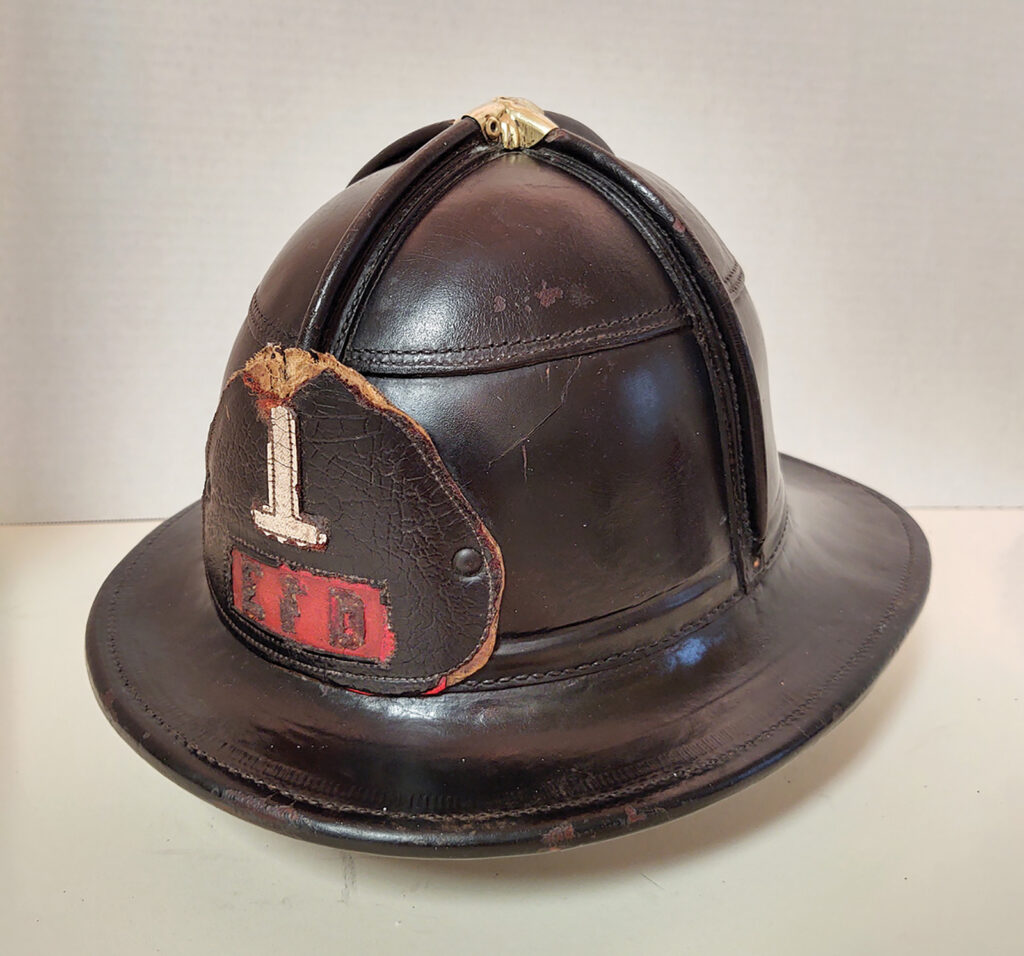
The American Fire Helmet Transition to Today
Just as the manufacturers of fire helmets first expanded in the 1800s, starting in the 1940s a variety of manufacturers began making fire helmets. Various materials were used including aluminum, metal, plastic, fiberglass, or composite helmets. They were cheap to produce but not always provided the same level of head protection that they should. Gary Ryman in his article, Top Hats to Tupperware: Fire Helmet History, wrote:
A generation later, in 1962, their vacuum-formed polycarbonate helmet line began; and in the “modern” era, Philadelphians, Phoenix, and Metro helmets were among the new style that some saw as a radical change from the classic shape. But it was radical only at first glance as even these helmets retained the short front brim and longer rear tail. Helmet types and styles have developed fans and detractors over the years.
Leather helmet devotees sometimes disparage the plastic models as “Tupperware.”32 Though some of the newer composite helmets were disparaged by the traditionalist firefighters, a number of the helmet brands became famous in TV dramas. One such is the television show Emergency in the 1970s, which follows the exploits of two firefighter/paramedics. Though the television dramas were fictional, they were based on real exploits of the LA County Fire Department, which at the time wore polycarbonate MSA Safety “Topgard” helmets.
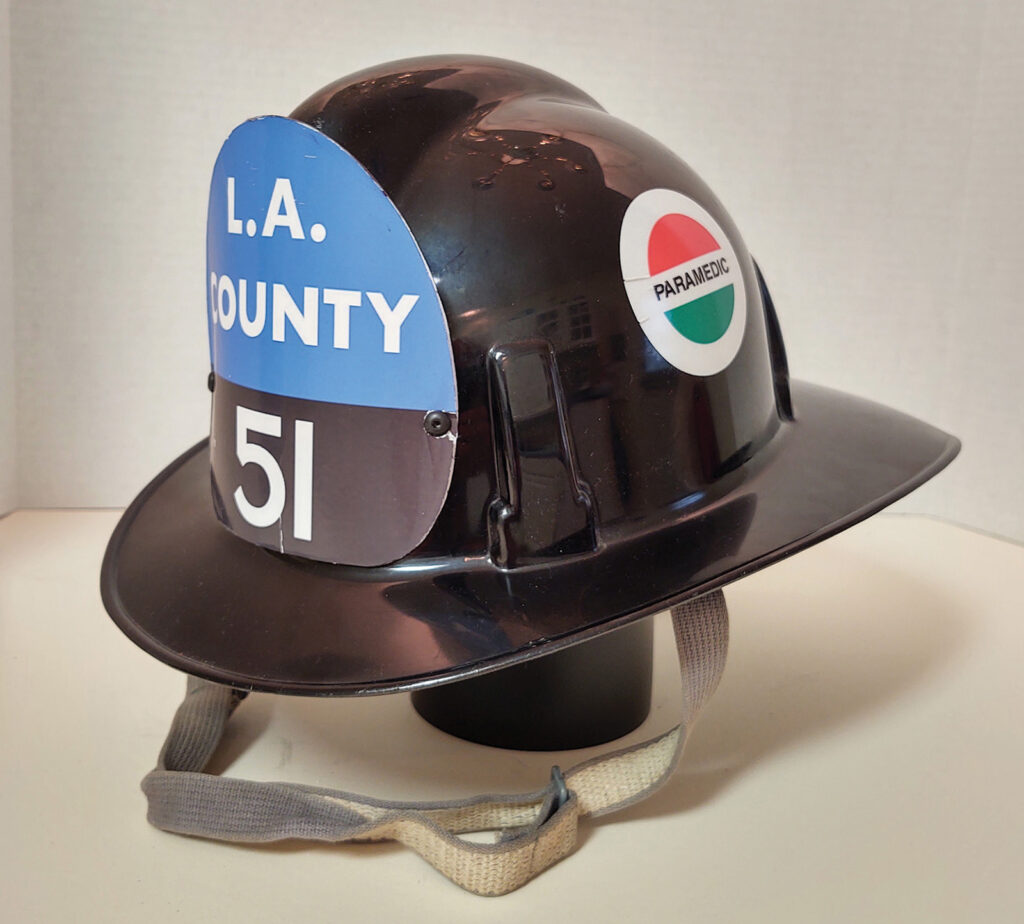
Today, all fire helmets have to meet a rigid standard for the safety and protection of the firefighter. The National Fire Protection Associations (NFPA) standards and the Occupational Safety and Health Administration (OSHA), regulations both help assure that firefighter personal protective equipment (PPE) including fire helmets are manufactured and maintained to appropriate standards.
Leather fire helmets are still available from prominent fire equipment manufacturers. If you are going to be using the helmet for actual firefighting and rescue, you need to make sure the helmet meets the current NFPA standards for structural fire helmets (NFPA 1971 – Standard on Protective Ensembles for Structural Fire Fighting and Proximity Fire Fighting), and are compliant with your state’s OSHA requirements. NFPA and OSHA-compliant helmets will be listed as such by the manufacturer.
Cairns and Brothers over the years became one of the leading manufacturers of firefighter protective helmets. In 2000, their helmet division was acquired by Mine Safety Appliances Company (MSA). After over 150 years of manufacturing helmets, they have transitioned to become part of the MSA line of firefighter protective equipment. The New Yorker N5A style leather fire helmets are still being produced and are available through MSA for the new and seasoned firefighter.
In the early 1970s, former California State Fire Marshal, Ronnie Coleman and former Assistant Chief of the California State Fire Training Division, Ray Russell came together to form Phoenix Technology to produce a new generation of contemporary fire helmets starting with the “First Due” fire helmet. In the early 2000s, they “decided to capture and preserve the rich history and tradition of the fire service by designing their very own traditional leather helmet.”33 They introduced the TL2 leather fire helmet which provides the firefighter with a leather helmet option that is compliant with NFPA standards.
The Continuing Traditions of the Fire Service Helmet
Beginning with the first fire helmets and continuing to this day, honorary or custom fire helmets were presented to valued fire company/department members upon retirement or achievement of a specified number of dedicated years of service. Also, honorary helmets may be presented to public officials or officeholders for their support or assistance. These helmets may be of recreated vintage style or current fire department helmets with a special insignia or helmet fronts. Some historic presentation helmets included ones with gold or silver metal fronts, some with inset jewels. These were quite expensive even in their day, and certainly a significant tribute to the individual. Antique presentation helmets with a confirmed provenance have significant historical value.
At the end of life, in cases of fire service line-of-duty-deaths or the passing of honored members of the fire department, the firefighter’s helmet may be used to set atop the casket or given a place of honor at the funeral ceremony. Afterward, it may be presented to the honored firefighter’s family in tribute to the firefighter’s life of heroic service. In some cases, the helmet may be draped with a funeral bunting or wreath as an additional tribute honor.
Though each of us has our personal memories about the first fire helmet we wore on duty, I would assume many of us carry a similar shared memory. No matter the materials or design of the fire helmet, besides its protective function, to a firefighter the helmet represents a symbol of pride, honor, and belonging in carrying out their sworn duty of the fire service profession. To the individual who wears it, the helmet represents a point of focus and meaning of their life. Some firefighters carry pictures of their loved ones inside the crown of the helmet. As they don this piece of protective clothing on each emergency response, they carry the memories and love of the family, both personal and fire service family, as they take action to save the lives and property of their fellow man.
Each vintage fire helmet carries its own history and story. A story of dedication and service of the many firefighters that wore the helmet, placing others before themselves in the protection of life and property. There could not be a more fitting representation of the firefighting occupation or avocation in which each of us serves than the iconic fire helmet.
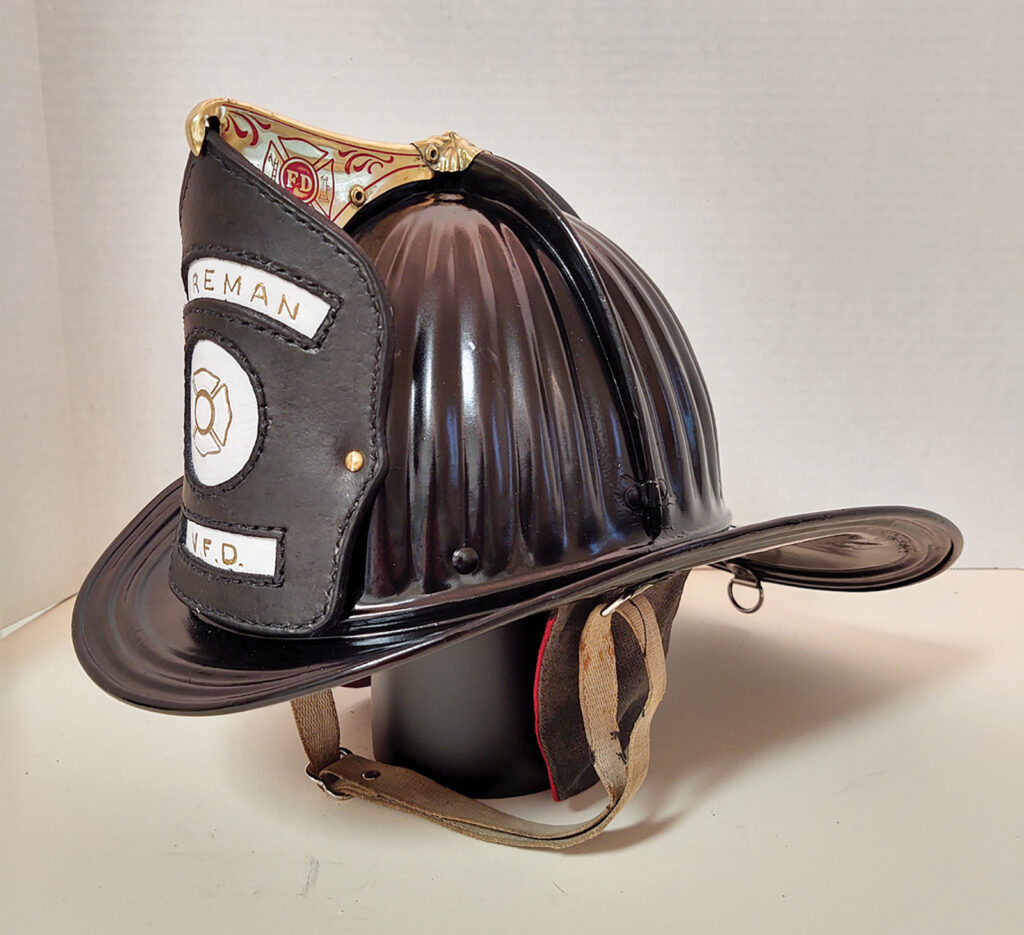
Author’s Comments
The author wishes to recognize and thank the fire service personnel and organizations for their assistance in the development of this article, and the University of Missouri Ellis Library/Lending Library for the inter-library loan of various research documents.
Endnotes
1
“Jacobus Turck”, Minor Decent, family genealogy website: https://minerdescent.com/2010/08/11/jacobus-turck/, accessed January 17, 2022.
2
Paul Hasenmeier, “The History of Firefighter Personal Protective Equipment”, Fire Engineering, June 16, 2008. Website article: https://www.fireengineering.com/fire-prevention-protection/the-history-of-firefighter-personal-protective-equipment/#gref, accessed Jan. 17, 2022.
3
Arnold Merkitch, Early Fire Helmets, Self-published, West Islip, NY, First edition, 1981, p. 5.
4
Ibid.
5
Ibid.
6
Ibid, p.6.
7
Ibid, p.17.
8
Ibid, p.18.
9
Martin Duchesne, Fireman’s Headgear in America, 1658-1918, English/French, 1st edition, Published by Author’s publication, Canada, 2008, p.20.
10
M.J. McCosker, The Historical Collection of the Insurance Company of North America, 1st Edition, The Beck Engraving Company, Philadelphia, 1945, p. 91.
11
“Fire Helmet Reading Hose 1”, Description/Gratacap on-line article, Smithsonian Institute, National Museum of American History, https://americanhistory.si.edu/collections/search/object/nmah_1333593.
12
Duchesne p. 42.
13
Merkitch p. 75.
14
Ibid, p. 8.
15
Ibid, p. 24-28.
16
Duchesne, p.20.
17
Merkitch p. 10.
18
Ibid, p.11.
19
Ibid, p. 17-19.
20
Gary R. Ryman, “Top Hats to Tupperware: Fire Helmet History”, Fire Men website, web article http://fire-men-book.blogspot.com/2013/06/top-hats-to-tupperware-fire-helmet.html, June 15, 2013.
21
Ibid.
22
“History of the Football Helmet,” Past Time Sports, Web article: http://www.pasttimesports.biz/history.html , accessed 1/17/22.
23
Firefighter’s helmet, Wikipedia, web article, https://en.wikipedia.org/wiki/Firefighter%27s_helmet , accessed Jan. 20, 2022.
24
NFPA 1971 – Standard on Protective Ensembles for Structural Fire Fighting and Proximity Fire Fighting Scope Edition 2018, NFPA, Quincy, MA, 3.3.101.
25
Merkitch, p. 12.
26
Duchesne p. 51.
27
Rev. Doug Farmer Chaplain, “Helmet Blessing”, web article: http://www.sandovalcountynm.gov/wp-content/uploads/2017/09/helmet_blessing.pdf , accessed Jan. 20, 2022.
28
Duchesne p. 59.
29
“Dating a Cairns 5A” Firehouse Forums, website: https://forums.firehouse.com/forum/firefighting/firefighters-forum/108881-dating-a-cairns-5a, Forum Member BKDRAFT post 10-29-2011, 05:41 PM, accessed Jan. 21, 2022.
30
Merkitch p. 61-62.
31
Ibid. p. 14-15.
32
Ryman.
33
“Our Story”, Phenix Technology, Inc., website page Copyrighted 2022, https://phenixfirehelmets.com/pages/about-us , accessed Jan. 20, 2022.
Photos
All photos were provided courtesy of the Smithsonian National Museum of American History and the author’s private collection.


